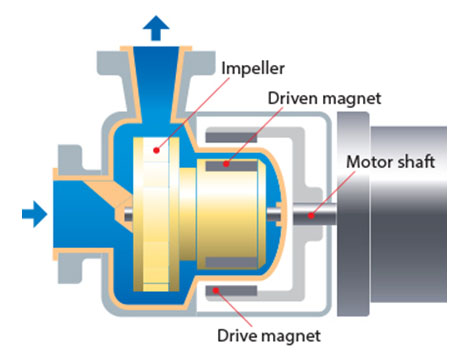All modern aquariums will have some kind of water pump, and these pumps need to be periodically cleaned and maintained. But why? What happens when a pump gets dirty? How do you clean a pump? How often do you need to clean your pump? We have the answers for you.
What happens when a pump gets dirty?
Nearly all aquarium pumps are magnetic drive pumps. With these pumps, the pump motor spins a magnetic drive magnet in circles. This magnet is inside the body of the pump and canít be seen or accessed. On the outside of the pump motor is an impeller (
or propeller) that spins around a shaft. The impeller has a magnet that is attracted to the magnet inside of the pump that is spinning so it spins too. A cover (
volute) covers the impeller and has an inlet or outlet molded into it to direct the water through the pump. Check out this
video from Iwaki to see how a magnetic drive pump works.
As the pump runs in an aquarium, build-up slowly gathers on the spinning impeller and inside the volute. This build-up can cause the pump to slow down, which reduces the flow and causes the pump to work harder to spin at the same speed. This causes the pumpís power consumption to increase. Additionally, the build-up on the impeller never happens evenly. Imagine spinning a top as a child. The top normally spins perfectly around its access just like a pump impeller should spin perfectly around the impeller shaft. Now imagine what would happen if you glued a small rock on one side of the top and then tried to spin it. The top would now wobble because it is not balanced. In the same manner, as a pump impeller gets dirty it starts to wobble around the shaft. This causes the pump to be louder and wear unevenly. Ultimately this uneven wear can damage the internal components of the pump, leading to pump failure and the need to replace parts such as the impeller and impeller shaft.
How do you clean your pump?
For light cleaning, disassemble the pump and clean all of the parts with a toothbrush or other cleaning brush. Sometimes pumps can get mineral build-up. This is more common in saltwater aquariums. In this case, a cleaning acid such as white vinegar or citric acid will help to dissolve any minerals built up on the pump components. Please see our
Using Citric Acid video to learn more about how to clean your pumps with citric acid. Keeping the pumps clean will keep them running quietly and energy efficient for a long time. If you choose to use Citric Acid, we recommend
Inland Seas Citric Acid Pump Cleaner.
How often should you clean your pump?
We recommend cleaning your aquarium pumps with a cleaning acid twice per year. You may want to do a quick clean with a brush more often. Powerheads, which are aquarium pumps that are inside the main aquarium display and used for water movement, often need to be cleaned more frequently because the light inside the display tank encourages algae to grow on them which leads to powerheads getting dirtier much faster than filter pumps, sump return pumps, or utility pumps.




























